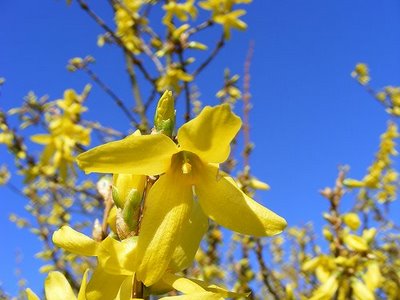
I’m happy to report the forysthia are blooming in Idaho. That means it’s time to prune the roses.
Pruning roses now rejuvenates the plant after a period of dormancy and stimulates growth. Before grabbing your clippers, however, keep these six simple steps in mind:
- For smaller rose canes, use a good quality scissor type of hand pruner, not the Anvil type. For cutting larger canes, use a pair of lopping shears with 18″ handles. Clean equipment with a solution made of one part household bleach to nine parts water. Or, swab shears with 70 percent denatured alcohol. This will reduce the spread of disease in your garden.
- Always prune roses at a 45 degree angle about 1/4 inch above the nearest outward-facing bud. The American Rose Society offers good illustrations. Wearing long, heavy duty gloves will help you avoid injuries.
- Remove dead, diseased or broken canes first. Also remove any suckers, which grow from the root section below the bud union. Then working from the bottom, clean out the middle of the bush to encourage good air circulation. Age isn’t appreciated with rose canes. So, prune out the oldest canes at the base to encourage strong growth of the younger canes. Clean up old leaves and debris where pests and pathogens may have overwintered.
- Different types of roses require different pruning methods. Hybrid teas, for instance, typically need more pruning than floribundas or climbers, according to Texas Cooperative Extension. Miniatures like to be pruned a few inches from the ground, and need to be divided every couple years.
- If your roses bloom once a year, always prune them after they bloom. Normally, they bloom on old wood, so you don’t want to cut off future flowers. I learned that lesson the hard way.
- Do you live in Florida, where roses grow year round in much of the state? If so, here’s what the University of Florida recommends.
For more tips, don’t miss the Rose Society of America’s section on pruning.











{ 2 comments }
I love seasons wisdom like this but have always been frustrated trying to apply it to Austin’s “seasons”. For example, there is no forsythia down here.
In most years I begin pruning when the redbud blooms. This year, however, we did not have a hard freeze in my garden and some roses were already blooming at that time, not having lost their leaves over winter.
One of the reasons I began keeping a garden journal was to see if I could come up with some of my own garden calendar tricks and tips.
Zanthan Gardens:
You’re right. These type of tips are often region-specific. Your garden journal is an excellent idea, and I admire your dedication.
I recommend gardeners check with local cooperative extension offices or master gardener organizations for area-specific planting advice.
Thanks for your comment. Hope to see you again. In the meantime, happy gardening…
Comments on this entry are closed.
{ 2 trackbacks }